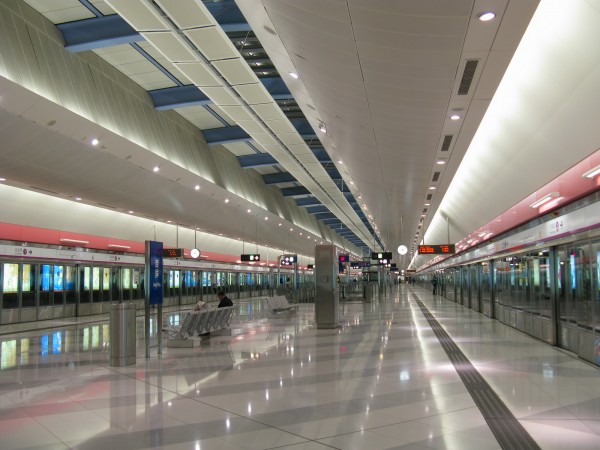Hong Kong MTR station to be turned into an archaeological museum?
| Robert Sarkanen | | May 06, 2014 01:56 PM EDT |

Following a heated debate in Hong Kong over the newly discovered Song dynasty relics, which are nearly 1000 years old, an archaeology group suggests a new museum - inside a metro station.
Like Us on Facebook
The find was made during construction of said To Kwa Wan station, with numerous artifacts and ancient buildings found nearby, including a well, a house structure and a nullah, a concrete-lined channel meant to allow heavy rains to be drained to prevent flooding.
For weeks, there had been intense debate on the future of the 14,500 square meter site in Kai Tak which has been in the process of excavation since November 2012, and was supposed to end last year, but is now set to continue until September.
The To Kwa Wan station was caught in the middle, and conservation groups called for its indefinite delay due to the proximity to the excavation, some even going so far as to call for the abandonment of construction entirely.
Conservancy Association director Dr. Hung Wing-tat, among others, called for the railway to be entirely realigned to preserve the site, as has already happened with a planned road that was supposed to pass through it.
Now the Hong Kong Archaeological Society suggests a compromise - that the MTR Corporation dedicates parts of their new station as an exhibition of the artifacts found while still retaining it as a functioning metro station.
Lobbyist groups cite examples in Athens, Rome and Paris, where train stations incorporate museum exhibitions housing heritage sites.
Difficulties first arose as the To Kwa Wan station would be a crucial link in the planned Sha Tin-Central link, which is due to connect to Hung Hom in 2018 and Admiralty in 2020 at an estimated cost of 10.3 billion USD.
The MTR Corporation, in charge of the Hong Kong MTR metro system and a major property developer and landlords in the area, already announced a two-year delay to the high-speed rail link after being ordered by the local government's Antiquities Advisory Board to study the site as a planning condition.
Protests have since abounded from another lobbyist group, Professional Commons, citing a conflict of interest to continue to let the MTR oversee the dig. Commissioning a rail operator to oversee an excavation doesn't sound like a recipe for archaeological success, after all.
Likewise, representatives of the MTR have noted the difficulties for the company in engaging in a field previously unknown to them.
Over 1000 boxes have been filled with items from the excavation labelled "general finds" and 3700 individual objects have been labeled "special finds".
Of particular note is the nullah, which is historically the first of its kind in Hong Kong, and suggests that the site was not just that of a small village but of a larger, possibly military installation.
The Song dynasty of China lasted from 960 A.D. until 1279 A.D. and was historically known as the first government in the world to issue banknotes and use gunpowder to repel its enemies. This was in addition to being a cultural high point with major advances in technology, science and engineering.
The dynasty was distinctly divided into two historical periods: The Northern (960-1127) and the Southern Song (1127-1279), during the latter of which the northern part of China was lost in conflict with the competing Jin dynasty.
It was during this time that the Song dynasty bolstered its navy to defend its waters from foreign invaders, which could possibly explain the nature of the discovery in Hong Kong.
The Song dynasty was eventually crushed by the invasion by Emperor Kublai Khan's forces in 1279, once again unifying China, this time under the Mongol Yuan dynasty.
TagsHong Kong, MTR station, Archaeology, Excavation, Song dynasty, Chinese history
©2015 Chinatopix All rights reserved. Do not reproduce without permission
EDITOR'S PICKS
-

Did the Trump administration just announce plans for a trade war with ‘hostile’ China and Russia?
-

US Senate passes Taiwan travel bill slammed by China
-

As Yan Sihong’s family grieves, here are other Chinese students who went missing abroad. Some have never been found
-

Beijing blasts Western critics who ‘smear China’ with the term sharp power
-

China Envoy Seeks to Defuse Tensions With U.S. as a Trade War Brews
-

Singapore's Deputy PM Provides Bitcoin Vote of Confidence Amid China's Blanket Bans
-

China warns investors over risks in overseas virtual currency trading
-

Chinese government most trustworthy: survey
-

Kashima Antlers On Course For Back-To-Back Titles
MOST POPULAR
LATEST NEWS
Zhou Yongkang: China's Former Security Chief Sentenced to Life in Prison

China's former Chief of the Ministry of Public Security, Zhou Yongkang, has been given a life sentence after he was found guilty of abusing his office, bribery and deliberately ... Full Article
TRENDING STORY

China Pork Prices Expected to Stabilize As The Supplies Recover

Elephone P9000 Smartphone is now on Sale on Amazon India

There's a Big Chance Cliffhangers Won't Still Be Resolved When Grey's Anatomy Season 13 Returns

Supreme Court Ruled on Samsung vs Apple Dispute for Patent Infringement

Microsoft Surface Pro 5 Rumors and Release Date: What is the Latest?









